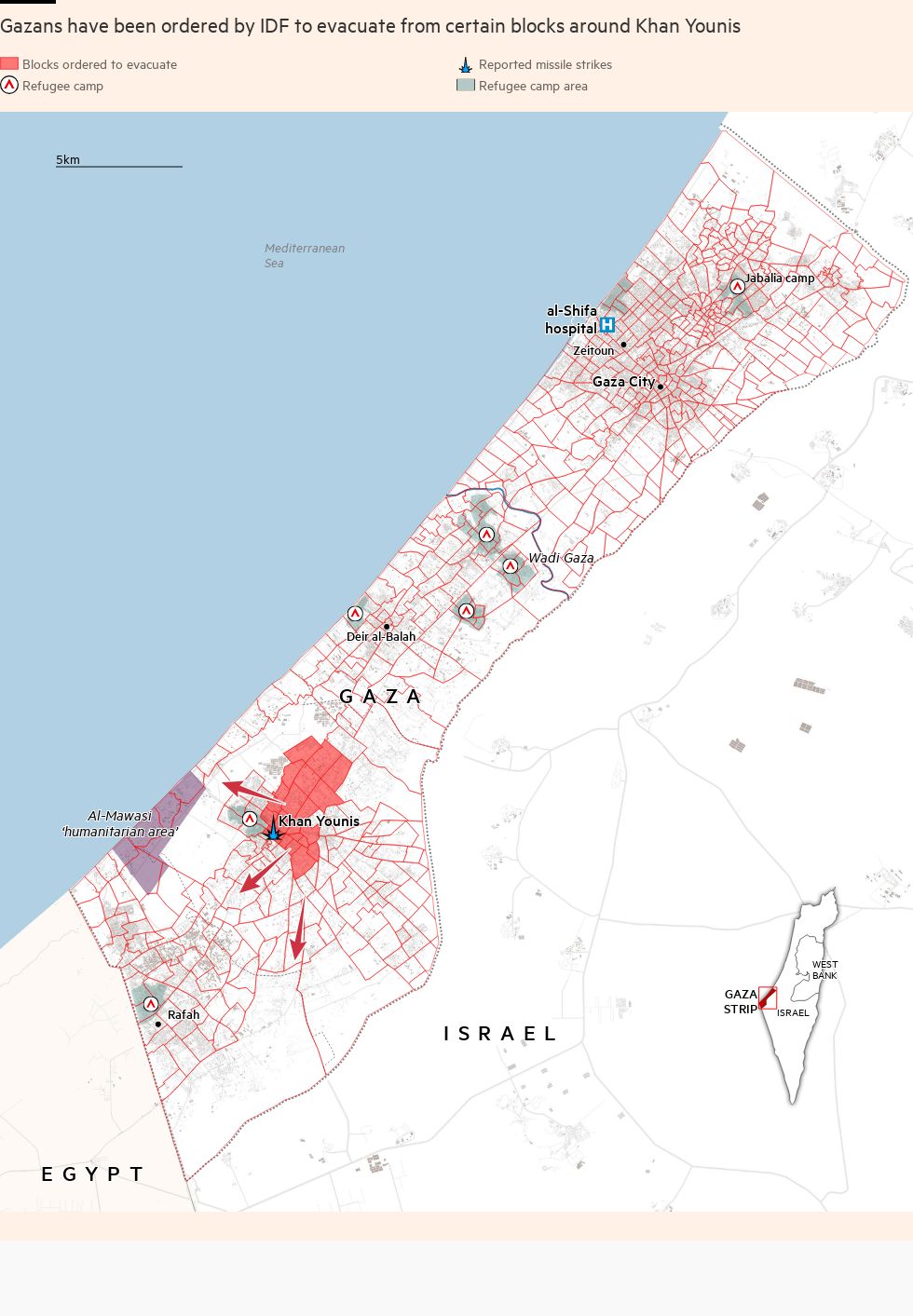Israel has defended its conduct of war with Hamas in the Gaza Strip by touting a high-tech evacuation plan for civilians, amid pressure from allies to reduce the number of casualties in the besieged coastal enclave.
The Israeli military’s ground offensive against the Palestinian militant group is turning to the southern part of the strip that is now home to about 80 per cent of Gaza’s 2.3mn population.
Israeli officials say they are adopting a different approach during this phase of the war to the one used in the north, where air strikes and then a ground invasion by the Israel Defense Forces led to the deaths of thousands of civilians.
The way “we’re going to operate [in southern Gaza] is going to be probably a bit different”, IDF spokesperson Richard Hecht told journalists on Monday.
“We need the time to defeat Hamas, and if we don’t make sure we make these efforts in the humanitarian sphere, in minimising the deaths of civilians, we may lose our legitimacy.”
But with hundreds of people reported killed in Gaza despite the new high-tech measures, Israel’s evacuation plans have been criticised.
Richard Ponzio, a former adviser at the US state department and a senior fellow at the Washington-based Stimson Centre think-tank, called the measures “woefully insufficient given the severe effects on civilians . . . since the resumption of air strikes and overall fighting”.
Civilians have borne the brunt of the war that was triggered by Hamas’s attack on Israel on October 7, when militants killed 1,200 people and took about 240 hostages, according to Israeli officials.
Israeli officials’ estimates of how many people have been killed in the enclave since the war began appear in line with figures issued by the Hamas-run Gaza health authority, which says more than 15,800 have died.
But the Israeli officials say that a third of those deaths — more than 5,000 — were militant combatants, resulting in a ratio of two civilians killed for every fighter.
Gaza health officials do not distinguish between combatants and civilians but say about 70 per cent of the dead and wounded are women and children.
Israel’s western allies have denounced the toll on ordinary Gazans as excessive, with US vice-president Kamala Harris insisting over the weekend that “Israel must do more to protect innocent civilians”.
The Israeli military says Hamas embeds itself in heavily populated areas, but insists it is trying to avoid civilian casualties.
It does this from a military base in Be’er-Sheva, 40km from Gaza, where Israeli soldiers and reservists process information on population movements inside the enclave using data from mobile phone, radio and television signals, as well as open-source information from local Telegram groups.
This helps generate a coloured map showing the projected population density of Gaza’s residential areas.
The fast-changing map is used by the IDF to issue evacuation orders to civilians, according to Israeli officials.
Localised evacuations have been introduced in southern Gaza since the collapse of a week-long Israel-Hamas truce on Friday. It is a different method to that used by the Israeli military in northern Gaza, when civilians were given a sweeping order to leave.
“Currently our operations are much more precise,” said a senior IDF official. “The efforts of evacuation are much more precise [and] we’re taking much more time to make sure the efforts are effective.”
A block map sent to civilians by the Israeli military is supposed to help them move to areas deemed safer by the IDF, in addition to evacuation warnings delivered by leaflets, phone calls and messages.
But with many civilians unable to access the internet, aid workers have questioned whether people can view the IDF’s online map.
The approach to evacuations is unusual, some experts say. “This is the first time I’ve ever seen an attempt to issue an evacuation order of this granularity and complexity in a highly dynamic military and kinetic environment,” said Hardin Lang, vice-president at Refugees International, a non-governmental organisation, and a former UN official.
UN officials have disputed the notion that anywhere in the strip is protected, given that Israeli strikes have hit hospitals, schools and shelters. “There is no safe place in Gaza,” UN human rights chief Volker Türk said on Sunday.
A senior IDF official said: “I won’t tell you we’re not doing mistakes. This is part of the challenge of war.”
Gaza residents say Israeli evacuation warnings are often issued at very short notice.
Hossam Fatehi, a father of five displaced to near the city of Khan Younis in the south of the enclave, said he and his family scarcely had time to flee a tower block after a warning — which came from screaming residents contacted by the IDF — before bombing started.
“We heard the sound of breaking glass and shrapnel,” he said. “I was looking around and behind me to check if one of us was killed or injured. I didn’t think we would survive.”
Gaza civil defence said about 20 Israeli strikes destroyed six towers in the development where Fatehi and his family, including his elderly mother, had been staying with relatives.
Ponzio said continuing civilian casualties in Gaza would heighten the pressure on Washington to rein in Israel. The death toll “steps up the pressure on the Biden administration to take more serious action to pressure Israel back to the negotiating table”, he said.
Additional reporting by Heba Saleh in Cairo and Neri Zilber in Tel Aviv































